|
|
|
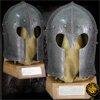 |
|
| Hanwei Barbuta Helmet (AH2192N) |
Points: 15

|
The Barbuta replicates a 15th century helm that was popular throughout Europe. Bearing a strong resemblance to the helmets of the ancient Corinthians, the Barbuta (or Barbute) was found not only with the facial cutout shape shown in our model but with a T-shaped cutout (no nasal) and with an open-faced rectangular cutout. Designed as a helmet for regular infantry, it fitted closely to the skull and nape of the neck and the sides almost touched the shoulders, affording very good protection.
Sold Out
|
|
|
|
|
|
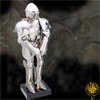 |
|
| Hanwei Knight in Shining Armour (MH1021) |
Points: 25
|
Replicating European suits of armour from the second half of the 16th century, these fully articulated pieces are made to one third scale. All are made to the highest quality standards and will be the focal point of any home decor. Each piece is complete with its own sword. Our "Knight in Shining Armour" (MH1021) is a spectacular conversation piece, crafted in highly polished stainless steel with a black lacquered wood base. The polished hardwood base and sword are specially made for this suit and finish the piece to perfection. Truly fit for a king's palace.
Sold Out
|
|
|
|
|
|
 |
|
| Hanwei Back Scabbard for Broadswords (OL1038) |
Points: 5


|
Our Back Scabbards OL1038 (Brown) and OL1038B (Black) are constructed in heavy leather to allow a sword to be drawn with the scabbard in place. The built-in versatility of the scabbard allows adjustment for blade lengths up to 41", at the same time providing for shorter swords by allowing their belt scabbards to be mounted to the back scabbard. Sufficient fitting adjustment is provided to accommodate chest sizes up to 48".
Sold Out
|
|
|
|
|
|
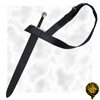 |
|
| Hanwei Sword Baldric (OL300) |
Points: 4
|
Our Baldric is worn diagonally across the chest and has an adjustable frog for use with a wide variety of scabbards, from rapier to broadsword. Sword not included.
Sold Out
|
|
|
|
|
|
 |
|
| Hanwei Fuku Riu Katana (CH1655) |
Points: 70

|
The blades of each of the Fuku-Riu swords are hand-forged from K120C powder steel. The blade style for the katana is of the style of Unokubi-Zukuri, ½ blood grove with a re-enforced Kissaki. The wakizashi does not have a bo-hi. The saya is a blend of green and black polished lacquer, unique to this line and a first for the forge. High quality ray skin (same) is used on the tsuka of the katana and wakizashi. The tsuba of the katana daisho are crafted in traditional blackened iron with a detailed depiction of the Fuku-Riu dragon holding a smoky agate “pearl”. The fuchi and kashira are also of blackened iron. The kashira depicts a dragon claw also holding an agate “pearl”, the pearl being set so that it is free to rotate within the claw, yet another first for the forge.
Limited edition - only 150 pieces of katana and 75 pieces of wakizashi.
Sold Out
|
|
|
|
|
|
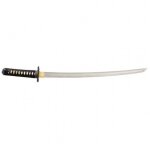 |
|
| Hanwei Fuku Riu Wakizashi (CH1666) |
Points: 50

|
Through Japanese history, dragons have been an integral part of the life and lore of Japan. This series has been designed to commemorate some of the most well know dragons found in Japanese myth and legend. Paul Chen’s Forge and designers have brought to life in this sword series not only a unique idea, but unique swords never before attempted in this genre.
Fuku – Riu - Japanese Dragon of Good Luck
Little is known of the Fuku-Riu. It is said, however, that if seen good fortune and luck will soon follow the beholder. The dragon is often depicted ascending heaven-ward, a sign of success in some circles. We have depicted this ascension in the Tsuba of the Fuku-Riu. The pearl being held by the dragon is also a sign of good luck and wealth. The design of this tsuba is a first for master sword maker Paul Chen and unique to this collection. The saya design is also unique to the series as it is a black-green blend…green being a color associated in Japanese history with luck. The Fuku-Riu dragon is rare in the literature of Japanese history but still a very important and integral part of the Tatsu Collection and a fitting first for this series.
Sold Out
|
|
|
|
|
|
 |
|
| Hanwei Shaolin Small Jie Dao (SH2441) |
Points: 2

|
The Jie Dao, which may vary greatly in size, is traditionally used by Shaolin monks not as a weapon (which is forbidden) but for domestic purposes, including shaving. When traveling on foot, the Jie Dao may be used to clear a path in the forest or to gather firewood. The “Jie” in Jie Dao means “abstain”, and Jie Dao translates as “the sword of abstention from killing”. This explains the deliberate lack of a sharp point and ascribes spiritual as well as functional value. The best known legend involving the Jie Dao tells of Huike, the successor to Bhodidharma, who cut off his left arm with a Jie Dao in order to demonstrate his sincerity to Dharma.
Sold Out
|
|
|
|
|
|
 |
|
| Hanwei Shaolin Jie Dao (SH2440) |
Points: 8

|
The Jie Dao, which may vary greatly in size, is traditionally used by Shaolin monks not as a weapon (which is forbidden) but for domestic purposes, including shaving. When traveling on foot, the Jie Dao may be used to clear a path in the forest or to gather firewood. The “Jie” in Jie Dao means “abstain”, and Jie Dao translates as “the sword of abstention from killing”. This explains the deliberate lack of a sharp point and ascribes spiritual as well as functional value. The best known legend involving the Jie Dao tells of Huike, the successor to Bhodidharma, who cut off his left arm with a Jie Dao in order to demonstrate his sincerity to Dharma.
Sold Out
|
|
|
|
|
|
 |
|
| Hsu Quandao (SH2212) |
Points: 18

|
Named for its originator, the great General Kwan Yu, The Quandao started life as a powerful military weapon weighing over 100 lbs., but has since evolved into a martial arts weapon weighing considerably less (ours is 6.6 lbs.). The un-edged high-carbon steel blade has a distal taper for balance and is engraved in a dragon motif with the traditional bell tassel attached to the hook. The wooden staff terminates in a quatrefoil pommel and the blood cup and guard have a distinctive antiqued finish. Lighter and better balanced than most Quandaos on the market, ours is ideal for the martial artist training with this formidable weapon. The stand for the Quandao (OH2290 available separatelly) is crafted in solid oak and displays the weapon beautifully in the vertical position.
Sold Out
|
|
|
|
|
|
 |
|
| Hanwei Butterfly Swords (Rattan) (SH2293) |
Points: 14

|
Butterfly Swords (or Eight-Cutting Swords) are believed to have been developed by Shaolin monks as a concealable defensive weapon, used to disable rather than kill, which was prohibited by the monk's code of conduct. The use of butterfly swords has since been honed to a fine art by martial artists, particularly the Wing Chun & Hung Gar styles of Southern China, where precision and two-sword coordination are emphasized. The CAS Hanwei Butterfly Swords Sets feature high-carbon tempered steel blades with traditional dragon engraving.
Sold Out
|
|
|
|
|
|
 |
|
| Hanwei Tang Jian (SH2349) |
Points: 25

|
Our Tang Sword is a Jian that exemplifies the artistry and symbolism in Chinese culture across many generations. The proportions and balance of the sword will appeal to the Taijiquan practitioner, while the unique fittings and decoration will establish its place in many collections. The lion-dog guard is fashioned after the shoulder guards of the Mingguang Armour, an important armour suit dating from the Tang dynasty, while the handle is wrapped in leather over ray skin in a traditional Chinese style for a superior grip. The diamond-section blade has both profile and distal tapers, making for a very quick sword, and is engraved with an ancient dragon pattern over most of its length,. The wooden scabbard is decorated in figured brass and is provided with a belt attachment. The throat of the scabbard fits snugly into the mouth of the lion-dog, an interesting and unique feature!
Sold Out
|
|
|
|
|
|
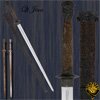 |
|
| Hanwei Qi Jian (SH2295) |
Points: 40
|
From the master swordsmiths of the Hanwei forge comes the Qi Jian, a re-creation of an ancient design that utilized one-piece forging. The entire sword, from pommel to tip, has been forged from a single billet of steel. This forging technique provides unparalleled strength and balance while exhibiting a clear, bell-like tone when lightly struck.
The sword's name originates with the Qi nation, one of the many warring states that eventually formed modern China. Legend has it that Feng-Xuan, one of the Qi people and a central character in a well known folk tale, possessed such a one piece sword and would use its ringing quality to accompany his singing.
The sword's grip is rayskin wrapped, a feature matched by the wrap on the throat of the scabbard, making for a stunningly beautiful presentation.
Sold Out
|
|
|
|
|
|
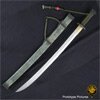 |
|
| Hanwei Beile Dao (SH2386) |
Points: 55
|
The original Beile (Lord in Manchu), also known as the "Banner Lords" and "Iron-Capped Princes" were the sons of Nurgaci, founder of the Qing Dynasty. After his death the Beile Hong Taiji was selected as Khan.
Our Beile Dao commemorates this Prince. Its beautifully detailed Iron furniture complements the patterning of the Damascus blade and the rayskin-covered scabbard adds to the rugged richness of the sword. Truly a collector piece and creating a demand in its homeland, this sword will only be available in limited quantities.
Sold Out
|
|
|
|
|
|
 |
|
| Hanwei Shinto Shinken Katana w Bohi (SH6004SGF) |
Points: 45
|
The Shinto Shinken Katana features a more traditional blade style than the other Performance Series models, specifically designed for a more frequent drawing practice, with a live sharp blade.
These live Iaito swords (Shinken) from Hanwei are made for the experienced Iaido practitioner who wishes to include light cutting (Tameshigiri) in his repertoire. The Shinken features optimized blade geometry, combining excellent balance with minimum weight for repetitive drawing, while retaining sufficient backbone for cutting light targets. The Shinto models have hand-forged high-carbon steel blades. Each blade is differentially hardened, to produce a distinctive hamon, and is grooved for balance and audible feedback in the cutting stroke.
Sold Out
|
|
|
|
|
|
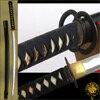 |
|
| Hanwei Musashi XL Katana (SH6003XGF) |
Points: 30
|
Miyamoto Musashi, arguably the most famous swordmaster in Japanese history, fought more than 60 duels before retiring and writing his famous treatise on swordplay, the "Book of Five Rings". Development of the two-sword style of swordplay, with the Daito (long sword) and Wakizashi being used together, is credited to Musashi. Mounted in black, the Musashi Elite is faithful to the original down to the famous double-ring iron tsubas. The tsuka-ito is in leather over ray skin. The blades are hand-forged in high-carbon steel, with new geometry to enhance cutting ability. It is edge-tempered using the traditional clay tempering method, resulting in a distinct hamon. Edge hardness is HRC60, back hardness HRC40. The grip is double-pegged to the tang for safety. The cutting style katanas (Elite, XL, XL Light) include a traditional maintenance kit.
Sold Out
|
|
|
|
|
|
|
|
Tags:
martial arts, katana, iaito, sword, fencing, tonfa, boken, bokken, kama, shinai, samuraj, judo, karate, kenjutsu, kenjitsu, ninja, kungfu,
|














